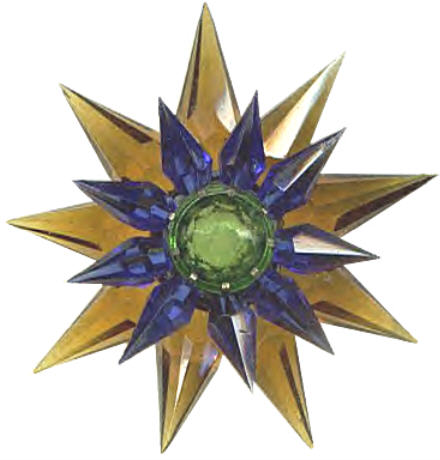 |
 |
 |
 |
|
CLICK HERE FOR THE TABLE OF CONTENTS PAGE AND LINKS TO ALL PAGES ON THIS SITE TABLE OF CONTENTS HISTORY THE TIMELINE MANUFACTURER'S HISTORIES THE PATENT PAGES THE PRE-ELECTRIC ERA VINTAGE ADVERTISING THE LIGHT SET GALLERIES RELATED LINKS
LEARN MORE ABOUT:
The Matchless Wonder Stars are some of the most highly collected of all vintage Christmas lights, and it takes only a brief look at these wonderful lights to see why... |
| STAR TYPE | COLORS |
| Series 100 and 200 single, miniature base lamps | PINK, RED, (DARK AMBER, ORANGE, AMBER), (EMERALD GREEN, DARK GREEN, GREEN), (LIGHT AQUA, DARK AQUA), (STEEL BLUE, COBALT BLUE), AMETHYST, CLEAR |
| Series 100, 200 and 500 Center Stones | RED, AMBER, DARK AQUA, BLUE, AMETHYST, GREEN, WHITE |
| Series 500 Doubles miniature base lamps | PINK, RED, AMBER, GREEN, BLUE, AMETHYST, CLEAR |
| Series 700 Doubles miniature base | RED, AMBER, GREEN, BLUE, AMETHYST, CLEAR (NO PINK) |
| Series 900 Doubles standard base | PINK, RED, AMBER, GREEN, BLUE, AMETHYST, CLEAR |
| Series 910 intermediate base | PINK, RED, AMBER, GREEN, BLUE, AMETHYST, CLEAR |
| Series 900 and 910 Center Stones | RED, AMBER, GREEN, BLUE, WHITE |
|
All of the above colors are also seen in the frosted variety of Stars. |
|
|
Note: This is an archive of the late Bill Nelson's "Antique Christmas Light" web site as it existed in 2001. Except for contact information, link updates, and some information that has been lost, we have attempted to keep the text and illustrations as Bill presented them. However, the original pages included much outdated HTML code and graphic conventions, so we have done a lot of work "behind the scenes" to bring you this archive. Consequently:
OldChristmasTreeLights? and FamilyChristmasOnline? are trademarks of Breakthrough Communications? (www.btcomm.com).
|

 | ||||||
| Visit our affiliated sites: | ||||||
| - Christmas Memories and Collectibles - | ||||||
 |

|

|
 |

|
 |
|
| - Family Activities and Crafts - | ||||||
 |

|

|

|

|

|
|
| - Music - | ||||||

|

|
 |

|

|

|
|
| - Trains and Hobbies - | ||||||
 |
 |
 |
 |
 |  |
|

|

|

|  |

|

|
|
